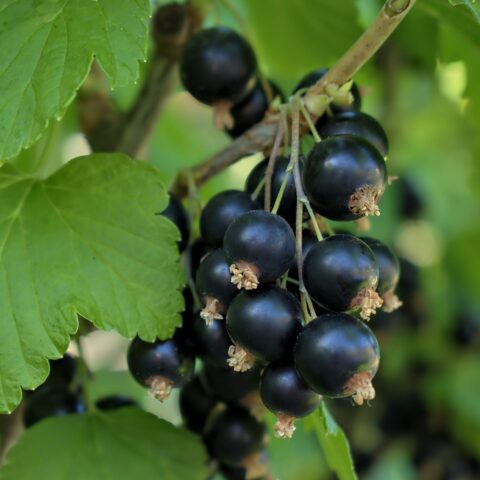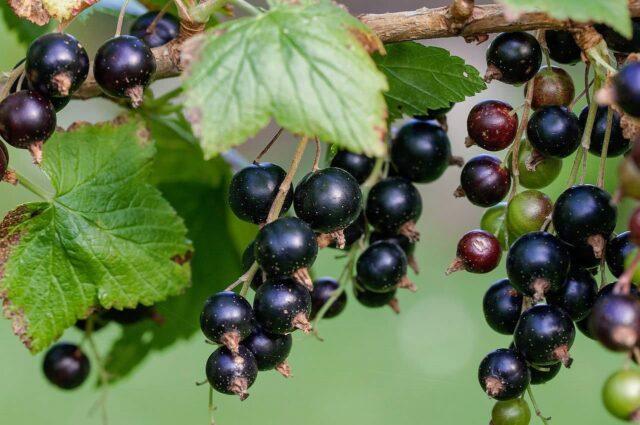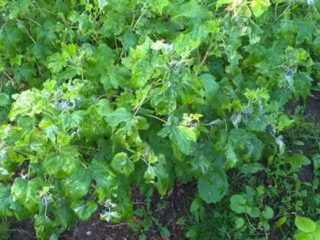Content
Currant Sibylla is one of the largest-fruited varieties of Russian selection. It produces tasty, sweet berries weighing up to 5 g. They ripen in early July. The variety is winter-hardy, approved for cultivation in Central Russia and the Far East.
History of selection
Sibylla is a blackcurrant variety obtained by breeders V.S. Ilyin. and Ilyina N.A. The application for admission was sent in 1993. After passing successful variety trials, the crop was included in the register of breeding achievements of Russia in 2008.
Currant Sibylla was bred at the South Ural Research Institute on the basis of two lines - Bredtorp and Golubka (seedling). It has good winter hardiness, so it can be grown in the regions of Central Russia and the Far East.
Description of the Sibylla currant variety with photo
In the description of the variety, you should pay attention to the characteristics of the bush, size, shape, and color of the berries. The main parameters are presented below.
Bush
Sybille currant bushes are low, moderately dense, and medium spreading. The shoots are medium thick, curved, green in color. The buds are free, located one at an angle to the shoot. The color is brown, there is no pubescence, the leaf scar has a rounded shape.
The leaves of the Sybil currant are five-lobed, medium-sized, green and light greenish in color, wrinkled, shiny, soft, the blade is concave. The blades are sharp, with the middle one exceeding the side ones with additional protrusions.
The lateral lobes are moderately developed and uneven. At the base of the Sybille currant leaf there is a notch, it can be deep. The teeth are sharp, medium. The petioles are long, thin, light green in color.
The inflorescences are small in size, narrowly goblet-shaped. The color is pale. They have free sepals of short length. They are bent, painted pale yellow with a pinkish tint. The brushes are small in length, from 4 to 6 cm, arranged singly. The axes are of medium thickness, green, curved, without pubescence.
Berries
The fruits of the Sybille currant are very large in size - weighing from 1.9 to 5.0 g, which is a record for many varieties. The shape is round, the color is almost black, the berries are relatively one-dimensional, each containing seeds. The calyxes are closed, the stalks are long, green, thin.
Characteristics of the variety
Among the important characteristics of the variety, mention should be made of the taste of the berries, yield, and ripening time. The most significant parameters are described below.
Taste qualities
The taste of Sybille currant berries is very pleasant, with a balance of sweet and sour, and received 5 points in the tasting assessment. It has a pleasant pronounced aroma. The harvest can be used fresh and for preparing preparations - preserves, jams, fruit drinks.

The fruits are large and very sweet
Therefore, it is recommended to freeze some of the fruits. In this case, you can preserve all the beneficial substances, including vitamin C.
Ripening time
Sybille currant is an early ripening variety; the first fruits begin to appear en masse in early July. The harvest can be harvested in several approaches. The variety is self-fertile, so the ovaries form independently - it is not necessary to plant pollinating bushes.
Productivity
The yield of the Sibylla currant variety is moderately high - 2.8-3 kg can be harvested from one adult bush. For industrial cultivation, 4.3 tons per hectare. However, this is not the highest figure - many other varieties consistently bring 3.5-4 kg per bush or more.
Frost resistance
The frost resistance of Sybille currants is good - the bushes can withstand up to -30 degrees without shelter. Therefore, they can be grown not only in the middle zone, but also in the regions of the Far East. Moreover, young seedlings must be covered and the tree trunk circle must be carefully mulched.
Disease resistance
The Sibylla currant variety has good resistance to powdery mildew, but is not resistant to bud mite. With improper care (excessive watering, lack of fertilizers), it can also suffer from other diseases and pests. It is necessary to take preventive measures regularly.
Advantages and disadvantages
The Sibylla variety is valued primarily for its very large and tasty fruits. They are sweet, juicy, with a pleasant aroma. In addition, the crop is winter-hardy, it can be grown even in regions with severe frosts.

Fruits of an attractive presentation
Pros:
- excellent berry taste;
- can be grown for sale;
- high winter hardiness;
- the bush does not produce many layerings, compact - saves space;
- immunity to powdery mildew;
- early ripening.
Minuses:
- no resistance to kidney mite;
- productivity is not the highest.
Features of growing Sybille currants
The variety is undemanding to care. But to obtain a stable harvest, it is necessary to plant on fertile soils, regularly water and feed. The basic rules of agricultural technology are described below.
Landing rules
Sybille currants are most often planted in the fall from mid-September to the first ten days of October (depending on the climate of the region). It is necessary to have time three weeks before the first frost. Fertile loam with a loose structure and a slightly acidic or neutral reaction pH of 6-7 is best suited for cultivation.
The place should be illuminated, without shadow. It is best to plant Sybille currants at higher elevations, since water periodically accumulates in the lowlands. If possible, the site should be protected from the wind on the north side of the garden.
Several months before planting, the soil begins to be prepared. They dig it up and add compost or humus in an amount of 7-10 kg per square meter. If the soil is clayey or dense, it is necessary to add 2-5 kg of sand or sawdust to the same area.
When planting a Sybille currant seedling, proceed as follows:
- Several holes are marked with a depth and diameter of 70-80 cm at intervals of 1.5 m.
- Place a layer of small stones on the bottom up to 10 cm high.
- Lay fertile soil, for example, a mixture of turf soil with humus, sand and black peat in a ratio of 2:1:1:1.
- Then the seedling is placed at an angle of 45 degrees and sprinkled with soil.
- Compact so that the root collar goes to a depth of 7-8 cm.
- Water with settled water.
- Trim all shoots, leaving 2-3 buds on each.
- After a few days, mulch with straw, hay, pine needles, sawdust or other materials. If winters in the region are too frosty, the layer height should be at least 15 cm.
Care instructions
To get a good harvest, it is necessary to organize proper care for Sybille currants. Young seedlings are watered weekly, adult bushes - 2 times a month, and during drought also every week. The water must first be settled - cold liquid will damage the roots.

To obtain a harvest, fertilizers are regularly applied
After watering or heavy rain, the soil needs to be loosened to ensure air flow to the roots. At the same time, weeds are removed. If you put mulch, there will be noticeably fewer of them, and the soil will remain moist longer.
Another important rule for caring for Sybille currants is regular fertilizing. The first is given in early April - you can add urea 20 g per 10 l or ammonium nitrate 15 g per 10 l. Then, during flowering, superphosphate (40 g) and potassium sulfate (30 g) are used. Instead, you can add complex mineral fertilizer. It will not be superfluous to feed with organic matter - 2-3 times per season the bushes are watered with mullein infusion 1:10 or liquid humate.
In early spring, sanitary and formative pruning is carried out. At the same time, Sybille currant bushes are treated with fungicides, for example, Bordeaux mixture or Abiga-Peak. In the summer, insecticides or folk remedies for insects are applied as necessary.
Conclusion
Currant Sibilla produces very sweet, beautiful berries. Its yield is not the highest, but the fruits are very large and sell well fresh.Growing bushes is not difficult; they can be grown both for yourself and for sale.
Reviews from gardeners about Sybille currants








